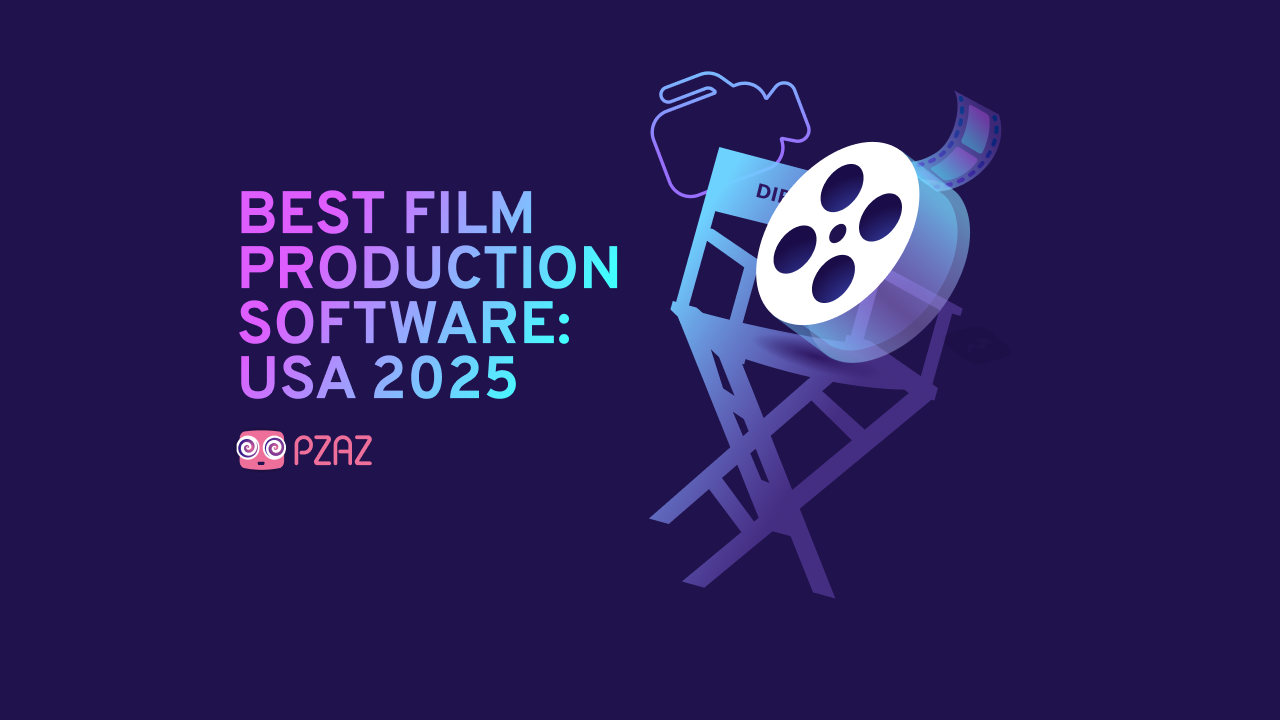Storytelling Trends & Statistics 2024 Worldwide
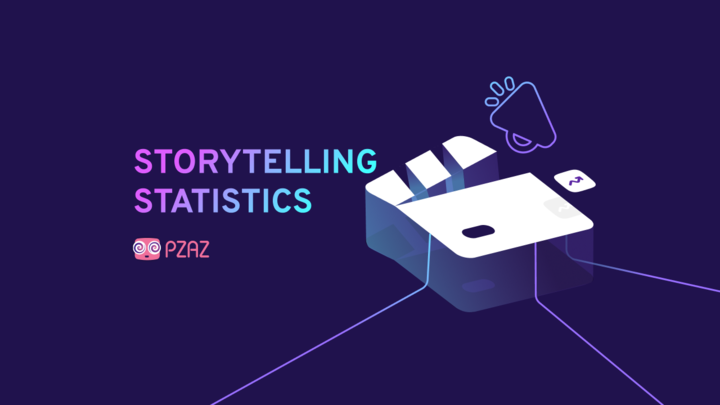
A Deep Data Dive into the World of Narratives in Filmmaking and Marketing
According to psychologist Jerome Bruner’s research, facts are 20 times more likely to be remembered if they’re part of a story. It’s unsurprising then that video is the most popular and effective marketing format and that 50% of marketers use video in their content marketing strategies.
Storytelling transforms raw narratives into something more humane and relatable and condenses concepts into believable, tangible ideas everyone can understand. The visual narrative also endears viewers to the characters portrayed and makes the messages expressed more memorable.
To gain better insights into storytelling’s impact on film and video marketing, we’ve surveyed over 4.1 million people on social media platforms like TikTok and Reddit for a full year, ending September 9th, 2024. Here’s what we found.
Index
- Data visualisation tech and tools are the most popular way to display data storytelling
- Nearly half of those surveyed use storytelling in their work
- Just under a quarter of respondents learned storytelling techniques from films
- Podcasts are the most used media type for storytelling in 2024
- Social media trends and interviews are the most significant sources of data-driven storytelling.
- Trust is the emotion that storytelling elicits most toward a brand
- Increased engagement is the major benefit of storytelling in marketing
- Research support is the most common way to incorporate AI into storytelling
- The age group with the highest storytelling engagement is age 65+
- More women than men are receptive to visual storytelling
- 35.9% of respondents earn between $120k and $200k a year
- Americans top the visual narrative content consumption market
- About the data
What kind of storytelling are you using in your work?
Nearly half of those surveyed use storytelling in their work
42.1% of over 4.4 million respondents indicated they use storytelling in their work, citing visual storytelling as the form they are most reliant on. Here’s how the use of storytelling in work stacks up.
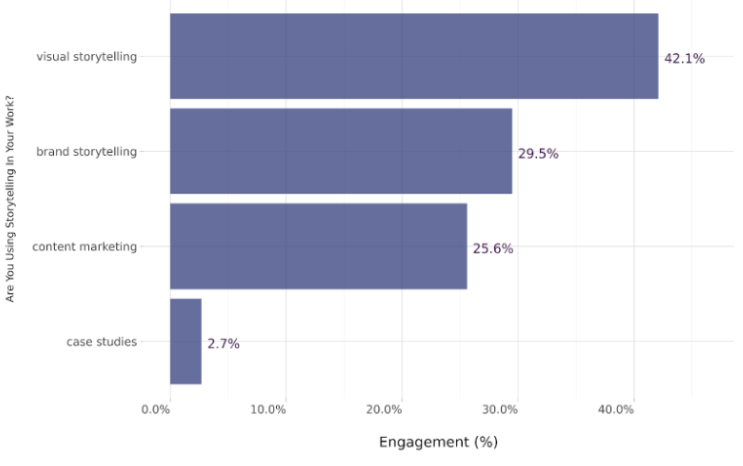
From LinkedIn to the Journal of Science Communication, everyone agrees that visual storytelling is one of the most important aspects of current-day marketing, highlighting its unique ability to engage both the senses and emotional impulses of consumers.
In addition to visual storytelling, survey respondents also state that brand storytelling (29.5%) and content marketing (25.6%) are key components of storytelling in marketing for more effective engagement and reach. Case studies, however, are not considered hugely important, garnering just 2.7% of survey engagement.
Where did you learn your storytelling techniques?
22% respondents learned storytelling techniques from films
Films and books: two of modern history’s most enthralling forms of visual storytelling to date—and the data reflects this fact.
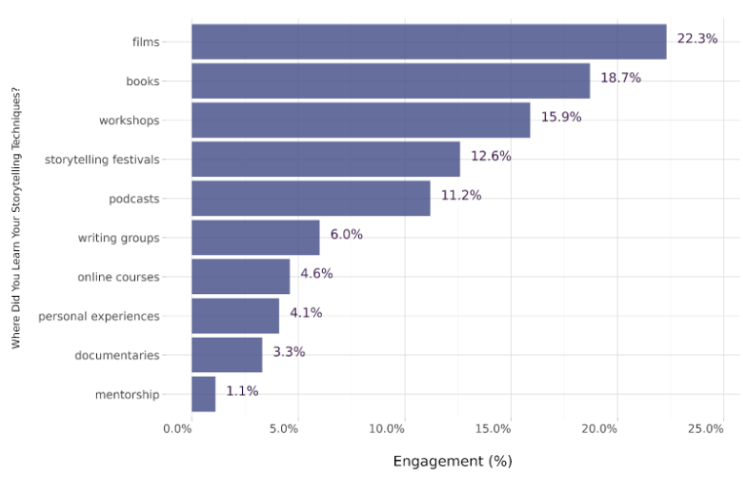
22.3% of respondents cited “film” as their source for learning storytelling techniques, and 18.7% cited “books.” Based on these two stats, it’s clear that for many people, storytelling still has strong classical origins.
Both films and books teach the greater consumer market a considerable amount about storytelling. However, other forms, such as workshops (15.9%), storytelling festivals (12.6%), and podcasts (11.2%), remain core aspects of how people are learning about different storytelling techniques in the digital age.
In the lower percentages, writing groups, at 6%, online courses with 4.6%, and personal experiences, at 4.1%, were also cited, while documentaries (3.3% and mentorship (1.1%) racked up minimal mentions.
Which media are you using for storytelling?
Podcasts are the most used media type for storytelling in 2024
Many different types of media are used to create stories for the consumer market today, but podcasts are among the most prevalent. Here’s what our results revealed:
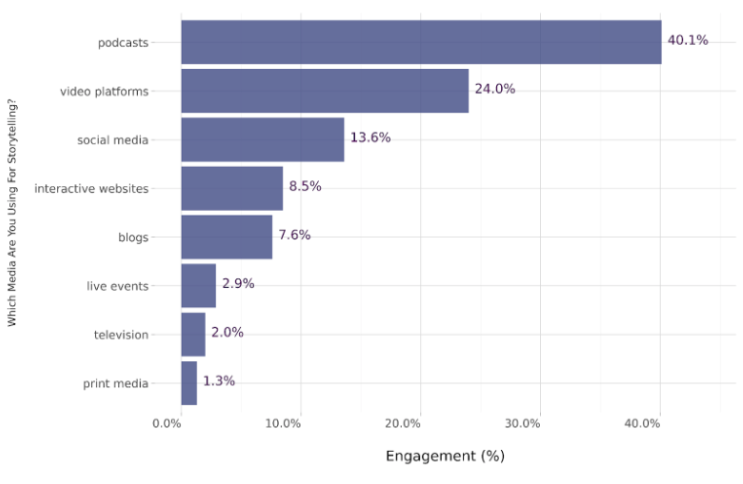
Accounting for a whopping 40.1% of the media type used by respondents, podcasts have skyrocketed in popularity in 2024. In fact, according to Edison Research, 59% of US consumers aged 12-34 have listened to at least one podcast in the past month, and 66% of consumers say they prefer podcasts to TV. The audio nature of podcast media may not be a form of visual storytelling, but it is a significant part of how current consumers want to experience storytelling.
Video platforms get just over half the engagement of podcasts at 24%, followed by social media at 13.6%. Interactive websites and blogs are closely tied at 8.5% and 7.6%, respectively, while live events (2.9%), TV (2%), and print media (1.3%) limp in last.
What is the most important element of storytelling for marketing?
The setting is the most important element of storytelling for marketing
There are many important elements to a successful story in marketing: the theme, point of view, dialogue, pacing, character development, and plot structure. However, according to the 4.2 million+ people we surveyed, the setting is the most vital to success.
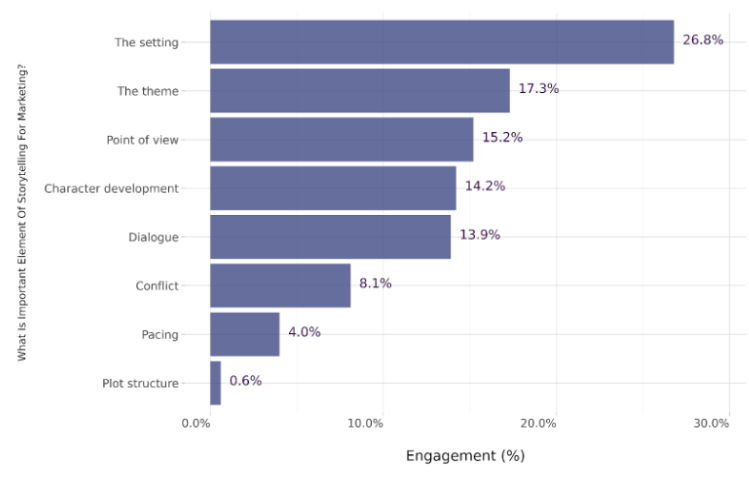
Representing 26.8% of engagement, the setting of a story is more crucial to effective storytelling than anything else. However, other sources indicate that plot overrules setting in the storytelling world. While the setting relates to atmosphere and environment, the plot focuses on the sequence of events that occur within them.
That said, the lowest percentage (0.6%) said plot structure was the most important storytelling element for marketing, highlighting a potential rift in approaches within the narrative-driven digital marketing sphere.
In between setting and plot structure was the theme at 17.3%, point of view at 15.2%, character development at 14.2%, and dialogue at 13.9%. Thereafter, there was conflict (8.1%) and pacing (4%) before dropping to the least important element at less than 1% engagement.
What emotions does storytelling elicit towards your brand?
Trust is the emotion that storytelling elicits most toward a brand
According to our results, a vast portion of people feel that trust is the most evident emotion their storytelling techniques elicit toward their brand. This is what the statistics show:
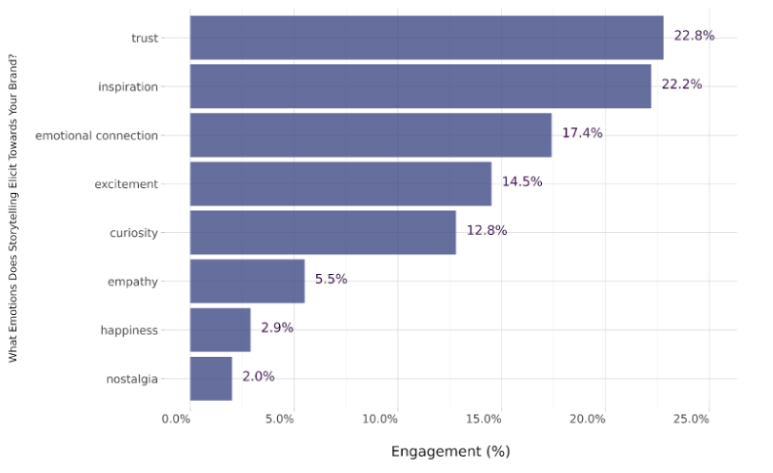
These findings are closely correlated with other brand marketing statistics. For instance, a survey from 2022 found that 81% of consumers hold trust as a crucially important factor in whether or not they choose to buy products or services from an organisation, and 95% are likely to stick with a brand they feel they can trust.
In a world where consumers feel jaded toward the barrage of content they are exposed to daily, brands that can win their trust are simply more likely to survive and thrive.
The next most prevalent emotions associated with brand storytelling are inspiration (22.2%), emotional connection (17.4%), excitement (14.5%), and curiosity (12.8%). Other emotions, such as empathy (5.5%), happiness (2.9%), and nostalgia (2.0%), accounted for the least significant in these particular survey results.
How has storytelling improved your marketing?
Increased engagement is the major benefit of storytelling in marketing
Storytelling has the potential to improve marketing strategies in a variety of ways, as the below graph reveals:
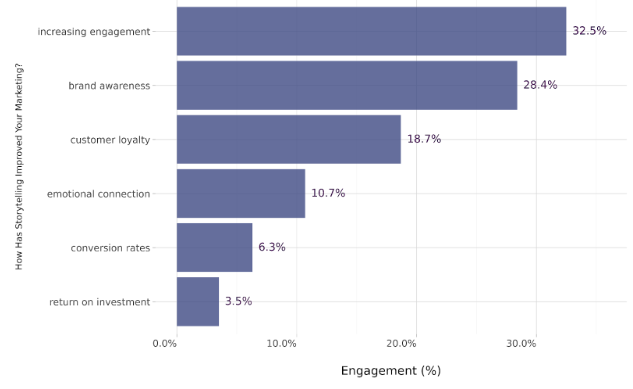
Considering that highly popular visual storytelling media varieties like video are some of the most engaging formats on the market, an increase in engagement is a very believable outcome for anyone that applies the lens of storytelling to their marketing strategy.
Another survey found that data-driven storytelling can increase sales by 30% and boost engagement rates by 300%.
Other ways that respondents claim that storytelling has improved their marketing efforts include brand awareness (28.4%), customer loyalty (18.7%), emotional connection (10.7%), and higher conversion rates (6.3%), with ROI taking last place at 3.5%.
What sources are you using to make your storytelling data driven?
Social media trends and interviews are the most significant sources of data-driven storytelling
Before people can create compelling, data-driven narratives and storylines through content, they need sources of inspiration and information. Our survey found that social media trends played the biggest role in data sourcing, with 30.8% claiming that trends on these populous digital platforms are where they gather their ideas. Check out what else we found:
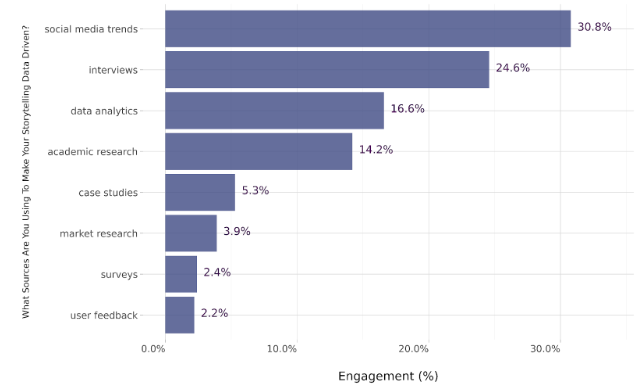
Interviews were the second-most popular answer, accounting for 24.6% of survey responses. However, data analytics (16.6%), academic research (14.2%), and others still represent active spaces for content creators to explore narrative trends and concepts. In contrast, case studies (5.3%), market research (3.9%, surveys (2.4%), and user feedback (2.2%) elicit minimal engagement and interest.
The fact that social media trends are such a popular answer in this case is unsurprising. Social media platforms are one of the fastest-growing industries in the world, making it an ideal digital space to pick up on and cultivate relevant storytelling ideas.
Which technology are you using to display you data storytelling?
Data visualisation tech and tools are the most popular way to display visual storytelling
Data visualisation tools top the charts, and charts and graphs come in last. This is what the graph reveals about the tech used to display data storytelling:
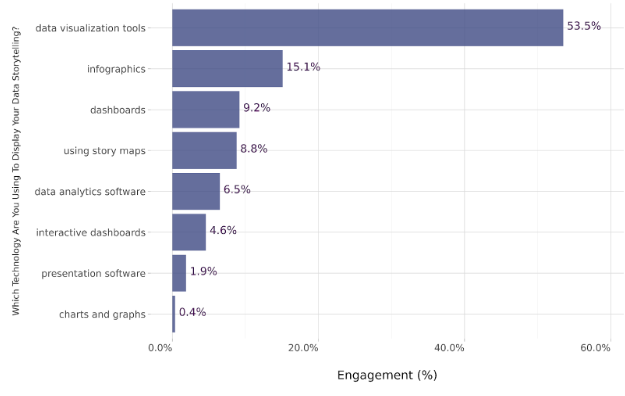
Our survey found that 53.5% of respondents use data visualisation technology as their number-one way to display visual storytelling. This aligns with other industry trends, as 90% of information the brain processes is visual. Based on this, the data visualisation technology market has a high CAGR of 10.95% and is expected to reach $16.54 billion by 2029.
The next most popular visual storytelling mechanism was infographics (15.1%), followed by dashboards (9.2%) and the use of visual story maps (8.8%). Interestingly, in the age of automation, data analytics software is only used by 6.5% and interactive dashboards at 4.6%. Presentation software ((1.9%) and charts and graphs (0.4%) have barely any engagement.
How are you incorporating AI in your storytelling?
Research support is the most common way to incorporate AI into storytelling
AI has been rapidly integrated into content creation, automation, and strategy development, being just a few. However, we found that research support is one of, if not the most, significant ways people incorporate AI into their marketing storytelling methodologies.
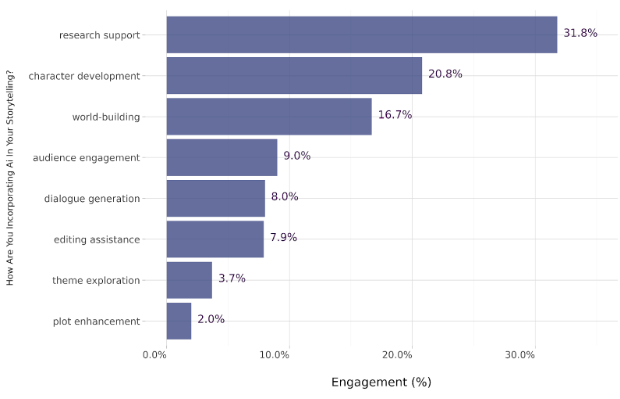
In the survey, 31.2% of respondents listed research support as the most relevant. This is likely related to the fact that 55% of Americans say they regularly use AI, whether for fun or business, to learn more about the world or entertain themselves on their own terms. 20.8% use AI for character development and 16.7% for world-building, highlighting AI’s potential in the creative sector, while 9% use it for audience engagement and 7.9% for editing assistance. Only 3.7% incorporate this technology for theme exploration, while just 2% use it for plot enhancement.
The age group with the highest storytelling engagement is age 65+
It’s common for people to associate media consumption, especially visual media consumption, with younger generations like Gen Z or Millennials. But our data indicates otherwise. The age group with the highest response rate was 65+, highlighting a connection between those from the Baby Boomer generation and compelling storytelling themes.
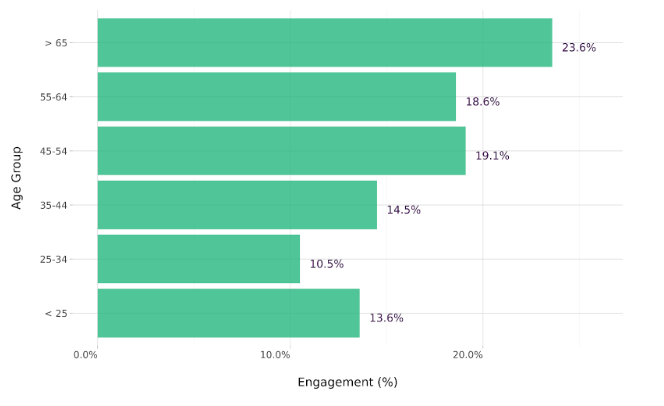
This may be due to the fact that generating emotionally compelling responses is more critical for older generations. Because they have less experience using and consuming digital content, Boomers rely more on their emotions and instincts to guide their media-related decisions.
Engagement for other age groups stacks up as follows:
45-54: 19.1%
55-64: 18.6%
35-44: 14.5%
Under 25: 13.6%
25-34:14.5%
More women than men are receptive to visual storytelling
There are some engendered aspects to how people create and interpret visual storytelling in film and video marketing. Our data shows that women engaging in the topic online make up 57% of the dataset, whereas only 43% were male.
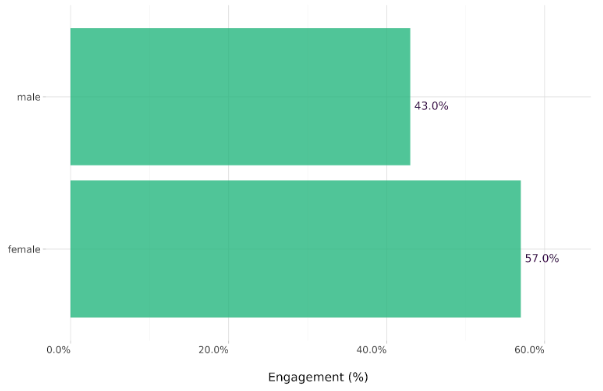
Despite the fact that women are more likely to face digital exclusions (that is, consume media specifically designed for male consumption as opposed to female or non-gendered consumption), they are more susceptible to being emotionally moved by it.
Bearing this in mind, video and film producers may stand to benefit more from creating visual content whose storylines align more closely with the feminine perspective, accommodating the evident interest in the art and techniques of storytelling in marketing and beyond.
35.9% of respondents earn between $120k and $200k a year
The engagement levels online clearly showed which income earners are most affected by visual storytelling, either from a corporate or consumer view:

Most of the survey respondents belong to the $120,000 to $200,000 annual income bracket. 26.9% earn $200,000 to $500,000, and the rest of the respondents either earn less than $80,000 (11.7%) or over $1 million (0.7%).
This range of income data suggests that people belonging to middle and working-class income brackets represent the majority of those producing or consuming narrative-driven video content.
Knowing this, content creators aiming to cultivate the broadest possible reach stand to benefit from producing content whose storylines resonate with people from moderate-earning backgrounds.
Americans top the visual narrative content consumption market
A vast majority (64%) of the respondents who participated in our survey are American. This could be due to various factors, not least of which is likely to be that US citizens simply represent a significant portion of the world’s visual content creators and consumers.

In fact, Americans are the foremost consumer market on the planet, meaning, as a nation, they consume more products and media than any other country in the world. The data also reveals that UK and German engagement was high. In contrast, Canada, Italy, Australia, Mexico, Spain, France, and Poland all had minimal engagement, ranging from 4.6% to 1.3%.
Based on this data, it’s clear that storytelling is playing a major role in marketing and that engagement levels online reflect this. Visual marketing is leading the way, and brands that incorporate this into their strategies will be the ones that stand out.
About the data
The data was sourced from an independent sample of 4,142 569 people worldwide from X, Quora, Reddit, TikTok, and Threads. Responses are collected within a 95% confidence interval and 4% margin of error. Engagement estimates how many people in the location are participating. Demographics are determined using many features, including name, location, and self-disclosed description. Privacy is preserved using k-anonymity and differential privacy. Results are based on what people describe online — questions were not posed to the people in the sample.
Best Film Screenwriting Software US in 2025
Find out what independent filmmakers want most in screenwriting software—from AI tools and cloud storage to collaboration features and bold design—and see how creative needs are shaping the future of writing platforms.
Best Film Production Software: USA 2025
Find out what filmmakers value most in their software tools, from editing support to progress tracking and post-production help, and learn why Pzaz is the ultimate creative partner in bringing your stories to life.


